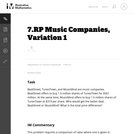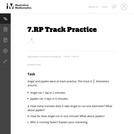
This task requires students to work with unit rates.
- Subject:
- Mathematics
- Material Type:
- Activity/Lab
- Provider:
- Illustrative Mathematics
- Provider Set:
- Illustrative Mathematics
- Author:
- Illustrative Mathematics
- Date Added:
- 05/01/2012

This task requires students to work with unit rates.

In this problem-based learning module, students will be given the chance to plan their idea of the perfect party. They are given a budget of $2,500, this is the maximum amount of money they can use. The goal is for students to plan a party that they think people would want to attend and would enjoy being a part of. The students will need to come up with categories of what their party will need (food/drink, decorations, entertainment, location, etc). These will then be the stations students will move at their own pace through to complete the party planning. At each station they will need to identify what they are doing to have/do for the party and how much it will cost. They will then have to figure out the unit cost (cost per person) for that category. The final station should allow for students to find the total cost of their part and total unit cost per person for the party. If the total cost exceeds $2,500 students should make adjustments as needed.Students will then create an advertisement (commercial, flyer, poster etc.) to promote their party as the “PARTY OF THE YEAR!”Students will then present these advertisements to school staff, parents, administrators etc. to vote on the party they would want to throw for their own child. They should take into consideration cost per person, entertainment, and enjoyment of the party.

This problem requires a comparison of rates where one is given in terms of unit rates, and the other is not.

The battle is on in this game where you build your own potions! Check your ratios to win this mixture mix-off. Ratio Rumble guides students in: identifying ratios when used in a variety of contextual situations; providing visual representations of ratios; solving common problems or communicating by using rate, particularly unit rates; and explaining why ratios and rates naturally relate to fractions and decimals.

Parts (a) and (b) of the task ask students to find the unit rates that one can compute in this context. Part (b) does not specify whether the units should be laps or km, so answers can be expressed using either one.

Students should have prior knowledge of rates and solving proportions. Students will be introduced to a problem that launches the lesson. By the end of the lesson, students should be able to answer the launch question. During the lesson, students will explore finding the unit rate, watch a video demonstration, and practice via whiteboards and interactively.

This problem is the fifth in a series of seven about ratios. In the first problem students define the simple ratios that exist among the three candidates. It opens an opportunity to introduce unit rates. The subsequent problems are more complex. In the second problem, students apply their understanding of ratios to combine two pools of voters to determine a new ratio. In the third problem, students apply a known ratio to a new, larger pool of voters to determine the number of votes that would be garnered.